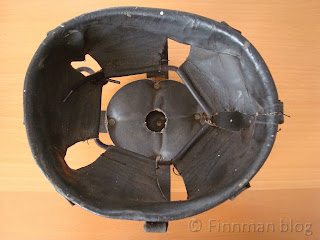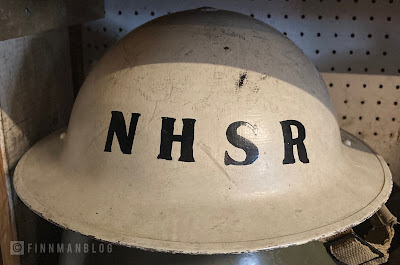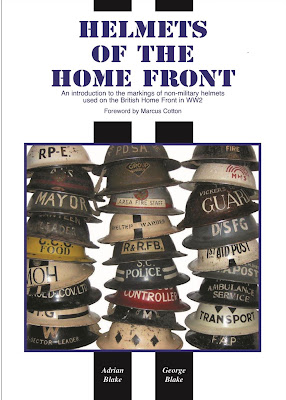 |
| British Police Officer 1941 |
This section is slightly 'off-topic' because it covers a period in time which precedes Avon & Somerset Constabulary. I also decided to include some more general information on British issue WW2 steel helmets.
UK West country Police forces operating during the Second World War included City of Bath Police, Somerset Constabulary and Bristol Constabulary. All of these were issued with steel helmets like the one shown below.
The example helmet pictured here is in excellent condition with most of the original paintwork and only minimal signs of corrosion under the stainless steel rim. This is an early issue version with the oval Mk1 helmet liner. The makers mark stamped on the metal inside rim is HBH which is Harrison Brothers & Howson Ltd of Sheffield. The helmet liner is stamped with the year 1938, size 7 and maker Vero I which is Everett W.Vero & Co London. The chinstrap mounts are also dated 1938.
Police were among the first civilian organisations to receive their steel helmets just before the start of WW2. The helmet shown above is dated 1939 and believed to have belonged to a Special Constable in Kent. It's identical to those issued to Bristol and throughout the UK. These helmets were painted dark navy blue even though they can appear black in photographs. However, I have seen a few black painted versions. The helmets were produced in large numbers and frequently appear on eBay. The first ones to be produced used an oval pad in the liner. All steel shells and helmet liners are stamped with the maker and date which can easily be researched on the internet. The Police were issued with military grade steel helmets. Most home front helmets were produced with a lower grade steel and can be easily identified since they typically have between 1-3 holes and occasionally 4 holes, stamped through the metal rim next to the chin strap rivet.
Good examples of these helmets will sell for around £50-£100. It's still possible to find good 'untouched' examples which have been stored for many years. The more dust on them the better!
British WW2 steel helmets with stenciling have become very collectible and values can be high. Because of this, there are many poor examples on eBay where someone has attempted to paint lettering on the helmet or 'touch up' old lettering in an effort to increase the value. The stencil used on the helmet pictured above is the standard type used on almost all British Police steel helmets from that period. Helmets were also produced with the letters "SC" for Special Constables above the "POLICE" but it was common for Special Constables to use the standard version. The only other type of letter stencil used had square lettering but these are not so common. It's also possible there are some further variations from countries such as Australia, which also adopted the MKII British style helmet.
This next example uses the same style of lettering and appeared on eBay in May 2017. This helmet is one of the early WW2 versions featuring an oval pad liner.
The example below appeared on eBay September 2019 with a £85 asking price. I would value this helmet at no more that £50.
A rare Inspector's helmet:
Finally, a scarce Superintendent's helmet:
These photographs confirm use of a second style of letter font from the WW2 period. It would be easy to dismiss this as a 'fake' if you were only familiar with the more common font. The lettering appears to be a type of transfer print as seen on the later cold war turtle helmet (see below). The white paint used on senior ranks helmets is usually brush painted. Needless to say the rarest senior rank versions are highly sought after.
Other examples include rank insignia such as sergeant stripes or white painted helmets including 'pips' which were used to designate senior officers (Inspector and above). These and similar types of helmets are rare and can easily sell for over £100. I would value the Superintendent version as shown above around £180.
Signs of rust or imperfections appearing under the stenciling could be an indication that it's not original. Hand painted letters on Police helmets are unlikely to be genuine. Hand painted helmets for civilians were more common as seen in the photograph below. Closer inspection can often reveal if it's genuine since reproducing painted lettering which looks over 70 years old is not easy. I've seen at least one seller on eBay who appears to have developed a convincing technique for 'aging' or 'distressing' paint on military helmets to make them appear much older or 'battle worn'. This is similar to the technique used to make new paintings look much older by coating them in a thin dark lacquer. Certain colour paintwork or stenciling can make a considerable difference to the value. This makes it an attractive proposition to re-paint an original helmet shell for profit. A tell-tale sign could be a liner which is in much poorer condition than the shell or chin strap which looks new but the shell is 'battle fatigued' - certainly something to be wary of. This particular seller seems to have a suspiciously copious supply of 'rare' helmets. They continue to fetch good prices so seem to be catching out many unwary collectors. It's easy to convince yourself something is genuine if that's what you want to believe. There's no doubt that the helmet shells are genuine, but the paintwork may have been 'touched-up' or even completely re-painted.
As already mentioned elsewhere in my blog, the power of suggestion can be very effective. For example by adding some suggestions in the description like "Victorian?????" or a few buzz words such as "8th Army". Serious collectors usually spot the genuinely rare helmets and bid accordingly. Demand remains consistent for such helmets and even those in very poor condition are attracting bids on eBay - rusty shells with little or no paint remaining.
Many years ago I collected military steel helmets and painted a completely rusted helmet shell in 'desert' yellow. It still had the original helmet liner but no chin strap. This was not an attempt to enhance it's value but simply for my own benefit because the helmet was in such poor condition. Eventually I had a clear out and either gave it to a second-hand shop or sold it at a car boot sale for a few pounds in the days before eBay. I wonder if this is now in the hands of a collector who believes it to be genuine? The shell was pitted from rust which would be evident under the new paintwork so that would be the most obvious 'give-away'.
I also had an example of a helmet with WW2 dated shell fitted with a 1950's liner and painted with brown texture paint. It was not uncommon for old helmet shells to be refurbished and re-used after the war by many countries. In the UK these were usually re-fitted with the simple elastic chin straps as used on the 'turtle' helmets. Finland was re-using the German made WW2 helmet shells after the war, even into the 1960's. The last of these has only recently been sold after long-term storage in Finland. As done in the UK, these were re-fitted with new chin straps and liners. Perhaps there are still WW2 helmets being stored somewhere in the UK by the MOD?
 |
| WW2 civilian 'gas company' steel helmet |
It's now reached the stage where the majority of WW2 British helmets on eBay are either very poor condition or have been re-painted in some way. It seems the supply of South African made helmets has almost dried up and the eBay seller I mentioned is now selling even rarer WW1 British steel helmets which again are slowly being drip fed onto eBay. I must admit that I didn't realise there was so many still out there! It was certainly hard to find such examples pre-internet. These helmets sell for around £200. Just imagine if you were able to reproduce these helmets to original spec and make them look old! You can even buy reproduction liners for the WW1 British Brodie helmets.
In comparison, WW2 German helmets routinely fetch hundreds or even thousands of pounds. The result of this is that some people will go to great lengths to re-produce authentic helmets from shells. Some are done to a good standard and sold as refurbished examples but there's always those trying to pass off something dishonestly that isn't what it appears.
Another recent trend is to mark names or initials on the chinstraps as well as paint names on the inside of the steel shell rim. This can make the helmet appear more unique and therefore more collectible. This was sometimes done by owners during WW2 but careful examination is needed to determine whether it could be a more recent addition. Other methods I've seen on eBay relating to military helmets is to add a net so you can't easily see the helmet surface. I've also seen some where camouflage paintwork has been carefully added to an original helmet and then a period photograph is included in the description in an attempt to give it provenience. One tell-tale sign of this is that the surface is given a paint 'wash' to give it an aged or distressed appearance. Some are genuine, but not many.
It's now possible to buy a completely new reproduction WW2 style British steel helmet. You might ask why? There seems to be a demand which I can only assume is from re-enactors or TV/film production companies. I've seen these on sale for about £50, which would get you a good genuine example for the same price.
These next photographs are an example of a Police helmet in poor condition. The rust is extensive over the entire shell and inside. Very little of the original paintwork has survived. Despite this, the "POLICE" lettering is still visible. It's likely that this helmet was stored in a damp environment for a long period. However, it retains the original liner and chin strap. What makes this unique is the addition of a felt 'skull cap' added to the liner for extra comfort by the owner. The owner's name is also written on the chin strap.
 |
| A Badly corroded WW2 steel Police helmet |
 |
| Steel helmet with homemade felt liner added |
 |
| The standard liner can be seen beneath the felt |
 |
| The extent of rust can be seen on closer inspection |
 |
| Owner's name and number on chin strap |
 |
| Makers stamps on the steel shell and date on the chin strap |
 |
| MKI helmet liner with makers stamp Everett W. Vero & Co. (London) |
It could be a tempting prospect to re-paint a helmet like this that's in such poor condition. Personally, I think such a helmet should be left as found despite the corrosion. Re-painting presents a number of problems and issues. Firstly, the helmet can no longer be regarded as 'original' or 'genuine'. The paint would need to be a good colour match and not brush painted. Achieving a smooth paint finish is unlikely with the amount of pitting from corrosion. Finally, the stenciling to match the original would be a challenge to most. In this case I think it's better to accept it as it is rather than try and make it into something it isn't. Perhaps the same can be said of cosmetic surgery!
The next photographs show an early pattern helmet liner (MKI) taken from a military issue helmet. The later versions of liner (MKII) had a central pad in the form of a cross. The central ’sponge’ pad and outer pieces loose their elasticity over time and become brittle. A single nut and screw through the centre is used to secure the liner to the helmet shell. I would not recommend trying to clean these liners since they can easily be damaged. It's best to leave them as found.
 |
| WW2 British steel helmet MKI liner |
 |
| External view of the WW2 British steel helmet liner |
 |
| WW2 home front steel helmet with later MKII design liner |
This next set of photographs below shows a well used Police helmet which was stored in a dry environment. Much of the surface paintwork has been scratched in the past and now shows signs of slight surface corrosion. However, such minor surface rust does not harm the appeal of a helmet which is in good original condition. If it was a car it would be described as 'an honest motor'. This helmet was purchased from eBay in 2009 for £25. Ten years later these were selling for about £50. However, a good example could sell for up to £100 in 2020.
 |
| WW2 British Police steel helmet |
 |
| Closeup of stencil |
 |
| WW2 Steel helmet MKI liner |
 |
| Makers stamp F&L = Fisher & Ludlow Ltd of Birmingham (1939 - 1942) |
After the Second World War it seemed like the world could look forward to a new era of peace and stability. It was soon apparent there was a new threat on the horizon in the form of the Soviet Union. During the 1950's there were preparations for a possible Third World War which included stockpiling new steel helmets for the Police. These were the newer Mark IV helmets, sometimes referred to as 'turtle' helmets because of the shape. They were painted a lighter blue than those issued during WW2 and used a "POLICE" transfer on the front but otherwise identical to those issued to the military. Many of these have the black circular marks on the top from when they have been in long term storage. They also had the standard green elastic chin strap as fitted to the military versions.
These are not currently very collectible so can be easily be found on eBay for about £20-£35. Some traders are asking £50 which is over-priced in my opinion. These were never issued and stored well so should be in very good condition.
 |
| 1950's/1960's British Police MKIV steel helmet |
It's also worth pointing out that many WW2 British steel helmets were reused after the war. Many were still being used in the 1960's during Civil Defence exercises by nurses and recovery teams. The nurses helmets were repainted white with black letters NHSR (National Health Service Reserve). The recovery teams were still using black steal helmets with a white letter R as they did during WW2. Many were refitted with the newer MK4 elasticated chin strap but some used the original straps. It's possible that some unissued helmets from storage were used for such purposes. This would make it difficult to prove if a WW2 helmet was actually used during the war or only post-war. In fact, it's not possible to know for certain if an army issue WW2 helmet was ever used in a theatre of war. Many were used on the homefront.
For anyone wanting a general introduction to steel helmets I can recommend the book "Tin Hats to Composite Helmets" by Martin J. Brayley. There's also plenty more information on this subject elsewhere on the internet such as here for helmet identification.
2024 Update







































